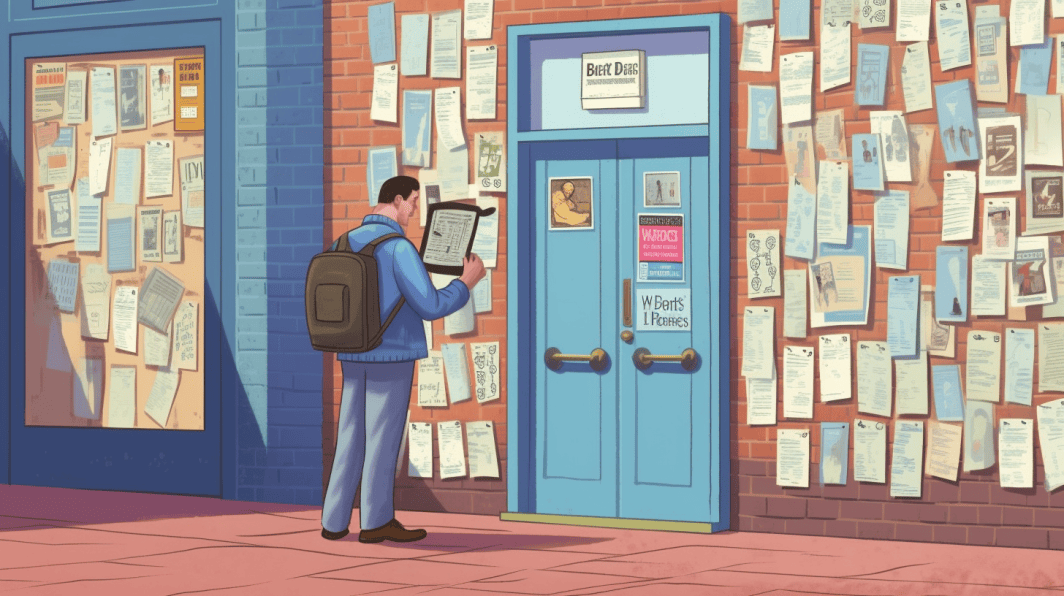
Letter of Recommendation Request: How to Ask and What to Include
Can a resume, on its own, land you a job? The guys who hire — and the sumptuously quirky film Legally Blonde (2001) — don’t think so: You need more than just a resume, and a letter of recommendation can increase raise the stakes. More than half (53%) of employers state that a CV alone doesn’t provide enough information to assess a candidate’s suitability for a job. Elle Woods from Legally Blonde took notice and turned in a pink, sweet-scented resume for shock value. But employers are increasingly interested in cover letters, professional portfolios, recommendations, and even links to social media profiles to gauge their candidates.
Therefore, all jobseekers should learn from peak 2000s comedy and reckon with the impact of recommendations on the hiring process. A staggering 69% of employers have admitted to changing their opinions about a candidate after speaking with a reference. This highlights the significance of strong and positive letters of recommendation to secure that coveted position.
Below, we’ll delve into the art of requesting a letter of recommendation and provide valuable tips on asking for one. We’ll also guide you on what essential information to include in your request to ensure your bid stands out. Join us as we unlock the secrets to acquiring powerful letters of recommendation that can make a real difference in your career trajectory
Identifying the right person to ask
When it comes to requesting a letter of recommendation, it’s not just about finding someone who knows you — it’s about finding someone who carries weight and authority in their field. Choosing a person with recognised expertise and credibility can significantly impact the value and influence of your recommendation letter. Consider individuals with a solid professional relationship with you and possess the authority to vouch for your abilities and experiences.
For example, you should seek a former manager who holds a high position within a well-known company, a respected mentor, or a trusted colleague who has achieved significant recognition. Their standing and authority can give your recommendation letter an extra edge, capturing the attention of prospective employers or institutions.

Additionally, consider individuals familiar with your work who can speak directly to your skills and achievements relevant to your chosen opportunity. A letter from someone with first-hand knowledge of your capabilities carries more weight than a generic recommendation from someone who merely acknowledges you.
If you’re still on the fence regarding whom to nominate for penning your letter, check if you can ask someone who the hiring manager knows of. Try your best to uncover who’ll be reading the letter in the first place, and then head to their profile on LinkedIn. If you happen to have any connections, you can start there. All in all, a friend dropping a line to your future manager might be even more potent than a scented, sumptuous letter.
In any case, always hedge yourself. Put together a list of at least three candidates in case one can’t help you out, and proceed to connect with the first. If you’re feeling bold, connect with more than one simultaneously, and you might end up with more than a letter.

Asking your sponsor for a letter of recommendation
When requesting a letter of recommendation, the timing and method of your approach can significantly impact the response you receive. Whether you’re reaching out to someone you have an existing relationship with or reconnecting with someone you haven’t worked with in a while, your approach must be strategic and considerate.
The process may be more straightforward if you ask someone you have an ongoing professional relationship with or have recently worked with. In this case, you can directly approach them in person or through email, expressing your interest in the opportunity and kindly requesting their support. Anecdotal reports demonstrate it won’t hurt if you first call to ask. Considering you’ve dusted off your landline and first introduced the idea by phone, you can use a sample request like:
“Hi [Name],
Thanks for your time over t1he phone. As we discussed, I’m approaching an exciting professional opportunity, namely [position/scholarship/opportunity], and I believe your endorsement would significantly give an edge to my application.
Having worked closely with you on [specific project/task], we agree that you’re a reference I can base my case around. If you are willing and available to write a letter of recommendation on my behalf, it would be incredibly helpful.
The best part — I’ll do most of it for you to check and sign.
Please reach out to me if you’re in, and I’ll fill you in with the details.
Thank you,
[Your Name]”
Suppose you’re talkative enough (and time zones allow for it), and you’ve already closed in on your recommendation letter on the phone conversation. In that case, you can proceed to send the details directly without an introduction.
However, if you’re requesting a letter from someone you haven’t worked with in a while or need to jog their memory about your qualifications, it’s crucial to remind them of your past connections and accomplishments. Start your request by reconnecting and highlighting your shared history, demonstrating that you value their opinion and the impact they can have on your application. You can use a sample request like:
“Dear [Name],
I hope this email finds you well. It has been quite some time since we last worked together, but I remember our collaboration on [specific project] and the valuable insights you provided.
I’m reaching out to you today because I’m currently applying for [position/scholarship/opportunity]. Your expertise in [relevant field/area] and your understanding of my skills and dedication would make your recommendation genuinely impactful.
If you are willing to write a letter of recommendation on my behalf, it would mean a lot to me. I can provide you with any necessary information or documentation to assist you in the process. Please let me know if there is anything else you might need.
Thank you for considering my request, and I appreciate your time and support.
Best regards,
[Your Name]”
You can always rely on the LinkedIn widget if you don’t have your colleague’s (or former colleague’s) email address. Head to LinkedIn (props if you’ve already left your profile page neat and slicked up) and search for your referral’s name. If you haven’t networked with them, send an invitation and — this step is very consequential — spell out your intentions in the small textbox LinkedIn allows you to fill in. “Hi [Name], It’s me again. I’m looking for a letter of recommendation, and yours would be especially solid. Can we chat? Thanks.”
Remember, regardless of whom you’re reaching out to, it’s essential to be personal, respectful, and appreciative in your approach. Explain why you value their opinion, acknowledge their expertise, and express gratitude for their time and support. Demonstrating your sincere interest and the significance of their endorsement makes you more likely to receive a positive response.
So, whether you’re approaching someone you know well or need to reconnect with a former colleague, crafting a thoughtful and tailored request can go a long way in securing a compelling letter of recommendation.
What to include in your request
No one, in the history of humankind, has ever answered in a focus group that their untapped passion is writing recommendation letters for strangers of sorts. Thus, it’s imperative to make writing a letter of recommendation as easy as possible for your sponsor. Doing so increases the likelihood that they will be willing to write the letter and put effort into highlighting your qualifications.
When you demonstrate consideration for their time and make it convenient for them, they will appreciate your responsibility and keep it in mind when crafting the letter. This thoughtful approach can lead to a more positive and impactful recommendation. Here are some details you should include in your request:
Turn in the whole blessed thing… ready to be sent off
We’re not bantering here — you can actually write the whole letter yourself and ask your referral to merely sign it off. You can check what to write and what to say right below.
If the person works at a specific company, including an official letterhead would be even more advisable. You can ask people from the HR department of that company — some of whom you might personally know — for a template and then fill it in there. If you’re lucky (and crafty) enough, the person you’ve contacted will sign off the letter with no modifications, and off you go. It seems like a sly man’s shortcut, but, in truth, it’s a very respectful way of asking for a favour — “I just need this tiny relic from you; since I understand you’re busy, I’ve pulled your weight, so it’s a breeze for you. By the way, how are things going on your end?”
Send the pieces to your backer for them to tack them together
Straight out from the era of faxes, memos, and uninterrupted lunch breaks, sending the pieces instead of writing the letter yourself is a defunct classic; it’s an ancient networking strategy that has aged woefully. With so much demand for attention, your advocate will probably forward your request directly to their assistant, who’ll phone in the task with a GPT-3.5 model for dismaying results. But — and not that there’s anything wrong with it — some corporate veterans are indeed old-fashioned, know their way out of distractions, and might prefer you send the pieces for them to elaborate. This is what you should broadcast to such a sponsor (and it’s what you should convey if you’re about to write the letter yourself):
1. Explain the purpose
Clearly state the purpose of the letter, whether it’s for a job application or any other specific opportunity. Provide a brief overview of what the opportunity entails and why it is essential to you. This will help the recommender understand the context and tailor the letter accordingly.
2. Fill in your relationship details
We all lose our old notebooks — either to spilled coffee or forgotten backpacks — filled with info about our acquaintances, so remember to cue the recommender of your professional relationship and highlight the period you worked together. Mention specific projects, tasks, or collaborations you were involved in. This will jog their memory and allow them to provide more specific and relevant examples in the letter. If applicable, mention any notable achievements or successes you had while working together, but avoid bringing up that one time the VP was travelling on a weekday—and you extended your lunch break to a bounteous three hours.
3. Mention key points or accomplishments
These can be related to your skills, character traits, or notable achievements that align with your desired opportunity. For example, if you’re applying for a software engineering position, you may want the recommender to emphasise your problem-solving abilities, teamwork skills, or successful completion of complex projects.
4. Tell them why their perspective is so important
Clearly explain why you believe the recommender’s perspective is valuable for the specific opportunity you’re pursuing. Highlight the aspects of your relationship or their expertise that make them particularly well-suited to vouch for your qualifications. This will reinforce the relevance of their recommendation and show that you have carefully chosen them for a reason.
5. Give the deadline
Specify the deadline by which you need the recommendation letter to be submitted. Provide clear instructions on how and where the recommender should submit the letter — through an online portal, email, or physical mail. Include any necessary contact information or forms they may need to complete. Making the submission process as convenient and straightforward as possible will increase the likelihood of timely and accurate submission. At least that’s what they taught you when they were your manager, didn’t they?
You can also use all those steps yourself. By including these details in your request, you will ensure that your recommender has all the necessary information to write a comprehensive and tailored letter of recommendation. This saves them time and increases the likelihood of receiving a solid, impactful endorsement that aligns with your desired opportunity.
Following up with a thank-you note
After you have made your initial request for a letter of recommendation, it’s essential to follow up professionally — whether your sponsor has written it for you or not. Here’s what you should keep in mind:
Checking in on your benefactor
If you haven’t received a response within a reasonable timeframe, sending a gentle follow-up message is acceptable. Remember that the person you’re requesting the letter from is likely busy, so a polite reminder can help ensure they haven’t forgotten. You can use a sample follow-up message like:
“Dear [Name],
I hope this email finds you well. I just wanted to follow up on my previous request for a letter of recommendation. I understand your busy schedule, so I wanted to ensure my initial email wasn’t lost in the shuffle. Please let me know if I can provide any additional information or clarification to assist you in writing the letter. I truly value your perspective and your recommendation's impact on my application.
Thank you for considering my request, and I appreciate your time and support.
Best regards,
[Your Name]”
Do not rinse and repeat. If you still don’t get a response, try to call up your contact — or proceed to your second option. That’s why you should always hedge yourself and have more than one potential sponsor on your list.
Expressing gratitude
Once the recommender has submitted the letter of recommendation on your behalf, expressing your gratitude for their time and support is essential. A sincere thank-you message or note will convey your appreciation. Here are a few sample sentences you could include in your expression of gratitude:
“Dear [Name],
I wanted to extend my deepest gratitude for taking the time to write a letter of recommendation for me. Your support and kind words mean a great deal to me, and I am truly honoured to have your endorsement. I’m grateful for your effort and thoughtfulness in crafting the letter, highlighting my strengths and qualifications for the [opportunity].
Thank you for going above and beyond to support my aspirations. Your recommendation holds immense value, and I am confident it will positively impact my application.”
Remember to tailor your thank-you message to reflect your genuine appreciation and the specific impact the recommender’s support will have on your goals. Whether you choose to send a heartfelt email or a handwritten note, your gesture of gratitude will leave a positive impression and strengthen your professional relationship.
Following up professionally and expressing sincere gratitude demonstrates respect for the recommender’s time and effort. These actions reflect your responsibility and foster goodwill and a lasting connection that may prove valuable in the future. It will also leave a strong lasting impression when you need to ask for a new favour.
So, in conclusion…
In the competitive world of tech, letters of recommendation can give you the edge you need to stand out. By carefully selecting the right person, making a thoughtful request, and providing all the necessary details, you increase your chances of receiving a compelling recommendation. Remember, the process is not just about asking for a favour; it’s about building strong professional relationships and showcasing your potential. It’s a given that if you’re out there taking this step, you’ve already mastered other more simple phases such as kicking your resume upstairs. Have you?
We hope these tips have been valuable in guiding you through the letter of recommendation request process. Now, armed with this knowledge, you’re ready to take the tech world by storm. Good luck on your journey, and may the letters of recommendation give you an edge sharper than C#.


